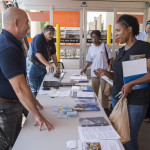TALLAHASSEE, Fla. – A Disaster Recovery Center has opened in Putnam County to help survivors affected by Hurricane Matthew. The center is located at:
Putnam County Fairgrounds
Building 1 – Expo Hall
118 Fairgrounds Rd.
East Palatka, FL 32131
Open Monday – Saturday
9 a.m. to 6 p.m.
Closed Sundays
Disaster Recovery Centers serve as one-stop shops for eligible disaster survivors seeking
one-on-one help. Representatives from the Florida Division of Emergency Management (FDEM), the Federal Emergency Management Agency (FEMA), the U.S. Small Business Administration (SBA) and various state agencies will be at the center to answer questions Monday through Saturday from 9 a.m. to 6 p.m. The center is closed on Sundays.
FDEM and FEMA officials continue to work closely with local officials in hard-hit areas to identify suitable sites for additional centers.
Downloading the FEMA App (available in English and Spanish) to their mobile device will allow survivors to:
- Apply for disaster assistance
- Get directions to the nearest Disaster Recovery Center by visiting DRC locator.
- Get weather alerts
- Subscribe to disaster safety tips
Many services available at disaster recovery centers are also available by calling the FEMA helpline at 800-621-3362. Survivors with questions regarding the application or the appeals process, or who need to register for assistance, may visit online at DisasterAssistance.gov or by phone (voice, 711 or video relay service /VRS) at 800-621-3362. (TTY users should call 800-462-7585.) The toll-free lines are open
7 a.m. to 10 p.m. seven days a week. Multilingual operators are available (for Spanish press 2).
Survivors requiring a reasonable accommodation (ASL interpreting, Braille Large Print, etc.) while visiting a disaster recovery center may call the appropriate helpline number above to receive support.
FEMA encourages survivors to register as soon as possible. Those who may have registered with their county emergency management office, the American Red Cross or other community organizations are reminded to also register with FEMA.
Disaster assistance may include grants to help homeowners and renters pay for temporary housing, essential home repairs, personal property replacement, and other serious disaster-related needs not covered by insurance.
SBA offers low-interest disaster loans for businesses of all sizes, homeowners, renters, and private
non-profit organizations. SBA disaster loans may cover repairs, rebuilding, as well as the cost of replacing lost or disaster-damaged real estate and personal property.
For more information about SBA loans, call SBA’s Disaster Assistance Customer Service Center at
800-659-2955, email disastercustomerservice@sba.gov, or visit http://www.sba.gov/disaster. TTY users may call 800-877-8339. Applicants may also apply online using the Electronic Loan Application (ELA) via SBA’s secure website at https://disasterloan.sba.gov/ela.
For more information on Florida’s disaster recovery, visit https://www.fema.gov/disaster/4283,
twitter.com/FEMAregion4, facebook.com/FEMA, and fema.gov/blog.
Source article –
Disaster Recovery Center Opens in Putnam County for Hurricane Matthew




